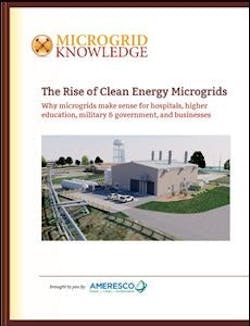This is the first article in a Microgrid Knowledge series that explores why the clean energy microgrid makes sense for hospitals, higher education, business, military and government.
Download the full report.
Interest is rising in the clean energy microgrid, especially within healthcare, higher education, government and business.
What’s the attraction?
All microgrids offer greater electric reliability. But the clean energy microgrid does more. It also reduces carbon emissions and helps organizations reach sustainability goals—an achievement increasingly valued by the healthcare community, business customers, government constituents, and college students, parents and donors.
How do they do this?
Clean energy microgrids produce electricity, and sometimes heat, using some combination of renewable energy, combined heat and power (CHP), and energy storage. In doing so, they are part of vibrant green trend sweeping the energy sector.
[clickToTweet tweet=”Renewable energy now provides almost one-fifth of U.S. electric generation.” quote=”Renewable energy now provides almost one-fifth of U.S. electric generation.”]
In fact, renewable energy now provides almost one-fifth of U.S. electric generation, and federal analysts forecast that it will be the fastest growing source of electricity over the next two decades. Meanwhile, energy storage is expected to grow almost seven-fold in just five years, according to research firm IHS.
Demand for CHP continues, too, as institutions and businesses seek out ways to make their energy supply increasingly efficient. This tried-and-true resource reuses a heat byproduct of electric generation that otherwise goes to waste in conventional power plants. Today, CHP represents eight percent of U.S. electric capacity, but has much more potential.
The growing use of microgrids is expected to hasten development of CHP. Navigant Research sees CHP use in microgrids nearly tripling from 655 MW in 2017 to 1,906 MW in 2026.
“Modern microgrids are a global phenomenon riding parallel currents of technology, climate, and policy change — and they may represent the biggest new opportunity for CHP in decades,” says Adam Forni, senior research analyst at Navigant Research. “In a growing symbiotic relationship, CHP brings mature baseload generation capability, while microgrids open new markets and improve integration with other distributed energy resources.”
When incorporated into a microgrid, the benefits of CHP — as well as renewables — heighten.
Keeps the power flowing during a grid outage
First and foremost, a clean energy microgrid keeps the power flowing even when the central grid fails.
First and foremost, a clean energy microgrid keeps the power flowing even when the central grid fails. Having on-site energy, alone, doesn’t necessarily achieve this. Many of those with solar panels are disappointed when they discover they cannot use their solar energy as backup during a power outage. That’s not the case if the solar panels are part of a microgrid. The microgrid will ensure continued supply of electricity.
This is one of the reasons installation of microgrids is growing in the U.S. — and worldwide. Again citing Navigant’s work, the microgrid market is expected to grow about five-fold, from 1.4 GW in 2015 to 7.6 GW in 2024 under a conservative estimate.
Recent hurricanes and cybersecurity threats have accelerated the call for this kind of energy. But there is another big factor too: energy cost management.
The newer, cleaner generation sources used in microgrids are dropping rapidly in price, increasing their appeal, especially in parts of the U.S. where grid electricity is costly. Solar costs have fallen steadily for years and are expected to drop another 27 percent by 2022, according to GTM Research. For some uses, battery costs fell as much as 70 percent in the last year. At the same time, natural gas prices — often used in CHP — remain at historic lows.
The clean energy microgrid as a price manager
There is another reason, too, that price-conscious customers — especially those in costly areas like the Northeast and California—are turning to microgrids. Advanced microgrid software and control technology can be programmed to leverage best prices. Without any human intervention, these microgrids choose among their internal resources, or between their resources and grid power, depending on which resource offers best pricing at any given point in time.
While the advantages of a clean energy microgrid are many, awareness of the technology remains limited. To help increase understanding about clean energy microgrids, Microgrid Knowledge and Ameresco have produced “The Rise of Clean Energy Microgrids: Why microgrids make sense for hospitals, higher education, military & government and businesses.” We welcome you to download the full report, and distribute the link widely, especially to those in the important sectors we focus on: healthcare, higher education, government and commercial and industrial operations.
Over the next five weeks, the Microgrid Knowledge series on clean energy microgrids will cover the following topics:
-
Clean Energy Microgrids for Hospitals
-
Clean Energy Microgrids for Colleges and Universities
-
Clean Energy Microgrids for the Military
-
Clean Energy Microgrids for the Commercial and Industrial Sector
-
Parris Island Microgrid Case Study
The full report, “The Rise of Clean Energy Microgrids: Why microgrids make sense for hospitals, higher education, military & government and businesses,” is downloadable free of charge courtesy of Ameresco.
About the Author
Elisa Wood
Editor-in-Chief
Elisa Wood is the editor and founder of EnergyChangemakers.com. She is co-founder and former editor of Microgrid Knowledge.
